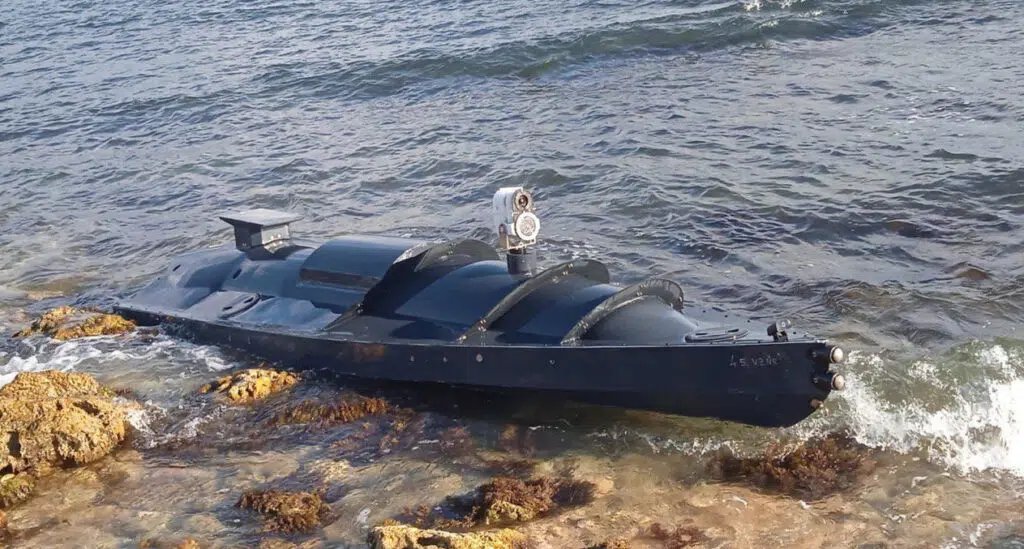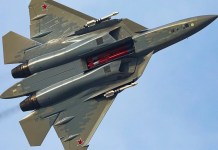An unknown unmanned surface vessel (USV), apparently an explosive-laden suicide drone, was allegedly found on a beach close to the major Russian Naval base of Sevastopol on the Crimean peninsula, per the claims by Russian authorities on September 21.
Brand New Su-57 Stealth Fighters Set To Join Russian Air Force; Developer Says Will Boost Production Of 5th-Gen Jets
US Achieves ‘Key Milestone’ To Intercept ‘Russian, Chinese’ Hypersonic Missiles; GPI Program To Enter Next Big Stage
“Today, a part of an unmanned water vehicle was discovered there. After examination, experts destroyed it,” said the Moscow-placed Governor of Sevastopol, Mikhail Razvozhaev, shortly after reports of an explosion in the Black Sea just off the coast.
In one of the images circulating on social media, a Russian Navy Project 775 Ropucha class landing ship can be seen far behind the USV, examples of which are known to be stationed in Sevastopol, suggesting the boat was indeed photographed near the city.
#Ukraine: An unknown uncrewed surface vessel was found today on the shores of Sevastopol, Crimea. As @CovertShores suggests – this mysterious USV could have been designed to be used as an explosive boat.
Full analysis can be found there –https://t.co/LCrqpwpU1A. Worth reading! pic.twitter.com/haWCr2lvH3
— ?? Ukraine Weapons Tracker (@UAWeapons) September 21, 2022
If true, it possibly indicates that the boat managed to slip past Russian Navy patrols to reach the beach.
However, considering that nothing is known about this drone vessel, it is bizarre that the Russians chose to blow it up unless they already knew what platform it was and what capabilities it had.
Boat Could Be Used For Surveillance And Reconnaissance
Based on the images of the drone, the USV appears to be a relatively small and shallow-draft design, powered by a single motor driving a steerable waterjet, indicating the drone can attain high speed.
The vessel’s small size means it is likely to have a minimal radar signature, which could explain how it remained undetected by Russian Navy patrols.

Experts have identified several sensors along the top of the vessel, which include the camera mounted on the mast and what appears to be a forward-looking infrared (FLIR) device, which is probably the primary sensor for steering and situational awareness.
Additionally, a flat antenna can be seen behind the camera, which according to analysts, possibly serves the purpose of navigation or communications. There is also a tiny camera or sensor at the bow, which appears to be trained forward.
Most notably, there are two steel protrusions on the bow. Some experts suggest they are sensors, while others opine they could be detonators or contactors for an explosive device.
From what can be seen immediately, the USV can undoubtedly be used for surveillance and reconnaissance missions. Ukrainian special forces are known to be undertaking waterborne raids in various parts of Ukraine.
The USV equipped with multiple sensors can gather intelligence about the target area before the mission and even be employed in a mission for situational awareness and post-mission damage assessments.
Interestingly, the US military aid package for Ukraine announced in April included unmanned coastal defense vessels.
What is an unmanned coastal defense vessel? https://t.co/J25vjByAID
— BJ Armstrong (@WWATMD) April 14, 2022
The Pentagon Press Secretary John Kirby said during a press briefing on April 13 that the USVs “can be used for various purposes in coastal defense” without providing additional details.
Unmanned Coastal Defense Vessel?
'I appreciate your interest in national security'#Pentagon #Ukraine #UnmannedCoastalDefenseVessels pic.twitter.com/AYJKHBzL6Y
— Espen Haug (@EspenHaug2) April 13, 2022
The mission set for coastal defense would certainly require surveillance and reconnaissance capabilities. Therefore it is possible that the USV in question could have been supplied to Ukraine by the US for coastal defense.
Another Possibility
As stated earlier, the two steel protrusions on the bow, according to some observers, could also possibly be detonators for setting off an explosive charge once the USV hits a large object, like an enemy ship.
The forward-looking sensor on the bow could be a laser range finding system to measure the distance to the target.
Furthermore, the Russian officials said the USV was destroyed, which suggests it was carrying explosives.
Since the onset of the war, the Ukrainian military has been employing explosive-laden commercial drones to strike Russia’s positions. Therefore, it should not be surprising if Ukrainians also use this capability in the maritime domain.
There is a precedent to this. In 2017, Iran-backed Houthi militants in Yemen used an unmanned explosive-laden boat to storm into a Saudi Frigate al Madinah in the southern Red Sea, which exploded at the stern of the frigate, killing two sailors and injuring three more.
The Ukrainian armed forces could employ such explosive-laden USVs to attack Russian warships outside the range of ground-launched anti-ship missiles such as the homegrown Neptune or the US-made Harpoon.
The USVs could also strike targets in highly secure port areas such as Sevastopol, where the drone was allegedly found.
Ukraine’s interest in attacking the Russian warships and the military facilities on the Crimean peninsula is no secret. Therefore more details about this new USV could soon emerge as the war in Ukraine progresses.
- Contact the author at tanmaykadam700@gmail.com
- Follow EurAsian Times on Google News




